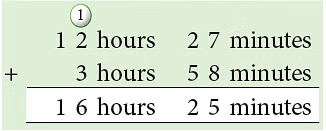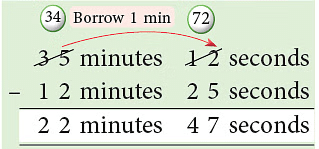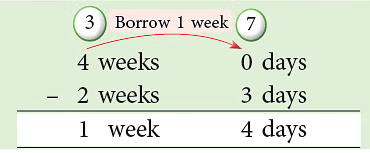Notes: Time | Mathematics & Pedagogy Paper 1 for CTET & TET Exams - CTET & State TET PDF Download
Time is a fundamental concept in mathematics and daily life, and it's an important topic for the CTET and other educational exams. Here's a brief overview:
Units of Time:
Seconds (s): The smallest unit of time.
Minutes (min): 60 seconds make up 1 minute.
Hours (h): 60 minutes make up 1 hour.
Days (d): 24 hours make up 1 day.
Weeks: 7 days make up 1 week.
Months: A variable length of time, typically measured in days or weeks.
Years: 12 months make up 1 year.
Time Measurement:
24-Hour Clock: The day is divided into 24 hours, starting at midnight (00:00) and ending at the next midnight (23:59).
AM and PM: Used to distinguish between times before noon (AM) and after noon (PM).

Time
- Time is the ongoing sequence of events taking place, the past, present and future.
- The basic unit of time is the second. There are also minutes, hours, days, weeks, months and years.
- We can measure time using clocks.
Types of Clocks

Units of Time
Some units for measuring time are given below:-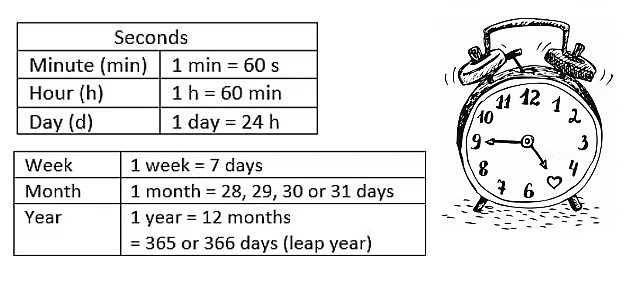
Time using AM and PM
- A day is divided into two parts: AM (Ante Meridian) and PM (Post Meridian).
- AM is from midnight to noon, and PM is from noon to midnight.
- For Example, Rahul had breakfast at 8:00 in the morning (AM).
- Rahul came home from work at 6:00 in the evening (PM).
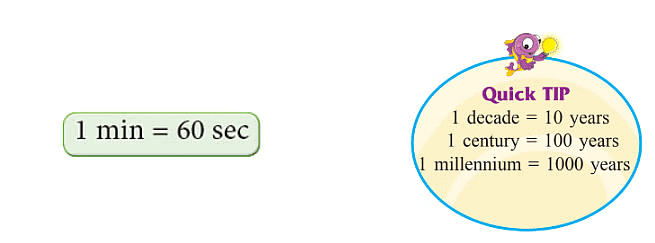
Hours, Minutes, and Seconds
- Most clocks have three hands: hour, minute, and second.
- The second hand moves quickly and measures seconds.
- A second is a very short amount of time, like the time it takes to smile or sneeze.
- When the second hand completes a full circle, it means one minute has passed.
- 1 minute equals 60 seconds (1 min = 60 sec).
- The clock shows hours from 1 to 12 and minutes from 00 to 59.
- Railways, airlines, and bus schedules often use the 24-hour clock.
- Instead of starting over at 1:00 PM after 12 noon, the clock continues with 13:00, 14:00, and so on.
- For example, 8:45 in the morning is written as 0845 hours, and 4:45 in the afternoon is written as 1645 hours.
Edurev Tips: 12 o’clock, noon time is written as 12 noon and 12 o’clock, midnight is written as 12 midnight. It is wrong to write 12 a.m. or 12 p.m.
Conversion of Units of Time
A. Conversion of Minutes to Seconds
We know that, Look at the following examples:
Look at the following examples:
1 min = 1 × 60s = 60s; 3 min = 3 × 60s = 180s ; 10 min = 10 × 60s = 600s;
2 min 10s = 2 min + 10s = 2 × 60s + 10s = 120s + 10s = 130s
B. Conversion of Seconds to Minutes
We know that, Look at the following examples:
Look at the following examples:
180s = (180 ÷ 60) min = 3 min; 1200 s = (1200 ÷ 60) min = 20 min;
107s = 60s + 47s = 1 min 47s
Or 107s = (107 ÷ 60) min = 1 min 47s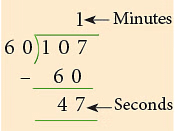
C. Conversion of Hours to Minutes
We know that, Look at the following examples:
Look at the following examples:
3 h = 3 × 60 min = 180 min
1 h 45 min = 1 h + 45 min
= 1 × 60 min + 45 min
= 60 min + 45 min = 105 min
D. Conversion of Minutes to Hour
We know that, Look at the following examples:
Look at the following examples:
360 min = (360 ÷ 60) h = 6 h
230 min = (230 ÷ 60) h = 3 h 50 min
230 min = 180 min + 50 min
= (180 ÷ 60) h + 50 min = 3 h + 50 min = 3 h 50 min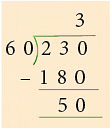
E. Conversion of Seconds to Hours, Minutes and Seconds
Look at the following examples:
2105s = (2105 ÷ 60) min
= 35 min + 5s = 35 minutes 5 seconds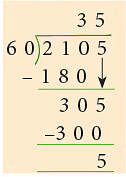 5430s = (5430 ÷ 60) min = 90 min + 30s = 60 min + 30 min + 30s
5430s = (5430 ÷ 60) min = 90 min + 30s = 60 min + 30 min + 30s
= 1 h 30 min 30 seconds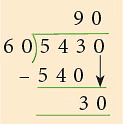

Edurev Tips:
- 60 seconds = 1 minute
- 1 second = 1 / 60 minute
- 60 minutes = 1 hour
- 1 minute = 1 / 60 hour
Operations on Measures of Time
A. Addition
Example 1: Add 12 hours 27 minutes and 3 hours 58 minutes
We write the time in hours and minutes in separate columns. Add as you do for ordinary numbers.
Thus, 12 hours 27 minutes + 3 hours 58 minutes = 16 hours 25 minutes.
Think:
27 min+ 58 min = 85 min
= 60 min + 25 min
= 1 h + 25 min
Example 2: Add 1 hour 20 minutes 36 seconds and 2 hours 45 minutes 55 seconds.
Thus, 1 hour 20 minutes 36 seconds + 2 hours 45 minute 55 seconds= 4 hours 6 minutes 31 seconds.
Think:
36 s + 55 s = 91s
= 60 s + 31 s
= 1 min 31 s
20 min + 45 min + 1 min = 66 min
= 60 min + 6 min
= 1 h + 6 min
1 h + 2 h + 1 h = 4 h
B. Subtraction
Example 3: Subtract 12 minutes 25 seconds from 35 minutes 12 seconds.
Think:
You cannot subtract 25 s from 12 s, so borrow 1 min from 35 min.
1 min = 60 s; 60 s + 12 s = 72 s;
72 s – 25 s = 47 s.
Example 4: Doon Express took 26 hours 37 minutes 10 seconds in travelling from Dehradun to Lucknow. Due to a techincal fault the train had a total stoppage of 8 hours 49 minutes 55 seconds at different stations. For how much time was the train moving?
To find out the time the train was moving, we need to subtract the stoppage time from the total travelling time.
Thus, the train was moving for17 hours 47 minutes 15 seconds.
Think:
Borrow 1 min.
60 s + 10 s = 70 s
70 s – 55 s = 15 s
Borrow 1 h.
60 min + 36 min = 96 min
96 min – 49 min = 47 min
25 h – 8 h = 17 h
Example 5: Subtract: 2 hours 40 minutes 50 seconds from 4 hours 25 minutes 31 seconds.
Thus, 4 hours 25 minutes 31 seconds – 2 hours 40 minutes 50 seconds= 1 hour 44 minutes 41 seconds.
Think:
Borrow 1 min = 60 s from 25 min
You now have 91 s.
91 s – 50 s = 41 s 24 minutes remain in minutes.
Borrow 1 h = 60 minutes from 4 h.
You now have 84 minutes.
84 minutes – 40 minutes = 44 minutes
24-Hour Time Notation
The 24-hour time notation is represented by a ‘24-hour clock’.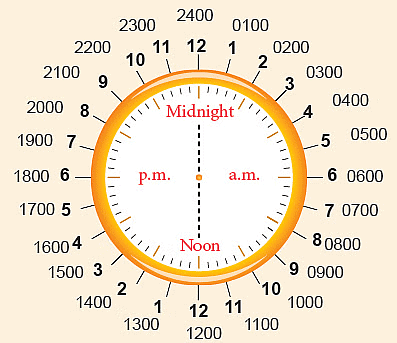 You already know that,
You already know that,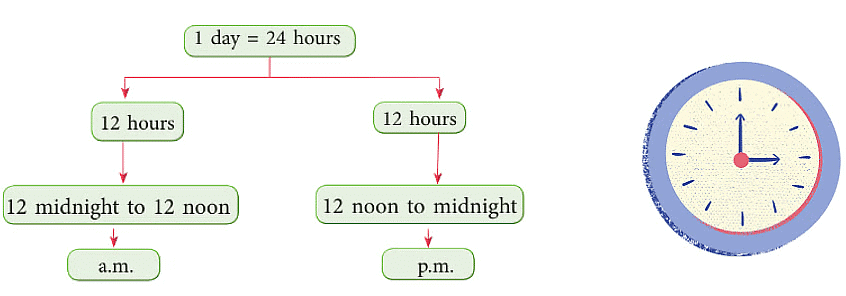 Thus, 2:35 a.m. = 0235 hours; 10:30 a.m. = 1030 hours 5:25 p.m. = 1725 hours; 9:15 p.m. = 2115 hours.Also, we have,
Thus, 2:35 a.m. = 0235 hours; 10:30 a.m. = 1030 hours 5:25 p.m. = 1725 hours; 9:15 p.m. = 2115 hours.Also, we have,
- 12 midnight in 24-hour clock is written as 00:00 or 0000 hours (start of the day).
- 12 noon is written as 12:00.
- 12 midnight (end of the day) is written as 24:00 or 2400 hours.
Elapsed Time
- We can use the 24-hour clock to easily figure out how much time has passed between two given times.
- It helps us find out how long something takes or when something started or ended.
- For example, if we know when something started and how long it lasted, we can find out when it ended.
- Or if we know when something ended and how long it lasted, we can find out when it started.
- We use addition and subtraction like in math to figure out these times.
- This helps us plan our day and understand how long activities take.
(a) 1652 hours to 2143 hours
(b) 2:35 a.m. to 5:30 p.m.
Sol: (a) The elapsed time is 2143 hours – 1652 hours.
Thus, the elapsed time is 4 hours 51 minutes.
(b) To find the elapsed time between 2:35 a.m and 5:30 p.m., first convert the time to 24-hour time.
Sol: Elapsed time =2 : 35 a.m. = 0235 hours5 : 30 p.m. = 1730 hoursThus, the elapsed time is 14 hours 55 minutes.
Example 7: Using a 24-hour clock, find the time.
(a) 3 hours 10 minutes after 2030 hours
(b) 8 hours 15 minutes before 2:35 p.m.
Sol: (a) Add 3 hours 10 minutes to 2030 hours to find the required time.
20 hours 30 minutes + 3 hours 10 minutes
= 23 hours 40 minutes (11:40 p.m.).
(b) 2:35 p.m. = 1435 hours = 14 hours 35 minutes
∴ Required time = 14 hours 35 minutes – 8 hours 15 minutes
= 6 hours 20 minutes
Thus, the required time = 6 hours 20 minutes = 0620 hours (6:20 a.m.).
Calendar
Years, Months and Weeks
By studying the calendar, we know that
Conversion of Years to Months and Months to Years
1 year = 12 months
5 years = (5 × 12) months = 60 months
3 years 7 months = 3 years + 7 months
= (3 × 12) months + 7 months
= 36 months + 7 months = 43 months
48 months = (48 ÷ 12) years = 4 years
25 months = 24 months + 1 month = 2 years 1 month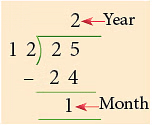
Example 8: A child is asked to complete two assignments in 4 weeks. He completed the first assignment in 2 weeks 3 days. How much time is left for him to complete the second assignment?
Sol: Remaining Time
Thus, the child has 1 week 4 days left to complete the second assignment.
Think:
0 < 3
Thus, borrow 1 week = 7 days.
7 days – 3 days = 4 days
Example 9: Ananya was 10 years 6 months old when her sister Tanya was born. Her sister is now 27 years 8 months old. How old is Ananya now?
Ananya’s present age = 27 years 8 months + 10 years 6 months
Thus, Ananya is presently 38 years 2 months old.
Think:
8 months + 6 months
= 14 months
= 12 months + 2 months
= 1 year + 2 months
|
30 videos|210 docs|69 tests
|
FAQs on Notes: Time - Mathematics & Pedagogy Paper 1 for CTET & TET Exams - CTET & State TET
| 1. How is time measured in the CTET and State TET exams? |  |
| 2. Are there any breaks provided during the CTET and State TET exams? |  |
| 3. Is there a penalty for exceeding the allotted time in the CTET and State TET exams? |  |
| 4. How can candidates effectively manage their time during the CTET and State TET exams? |  |
| 5. Can candidates request additional time accommodations for the CTET and State TET exams? |  |

